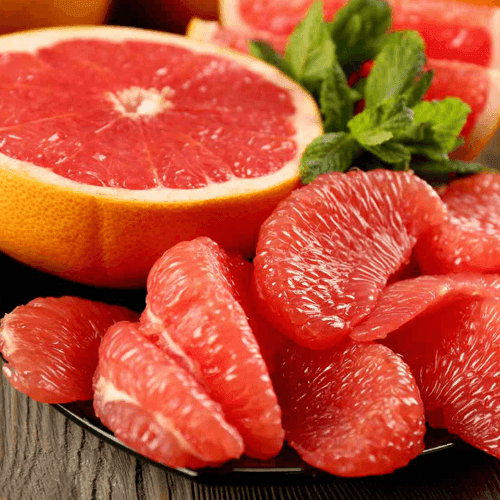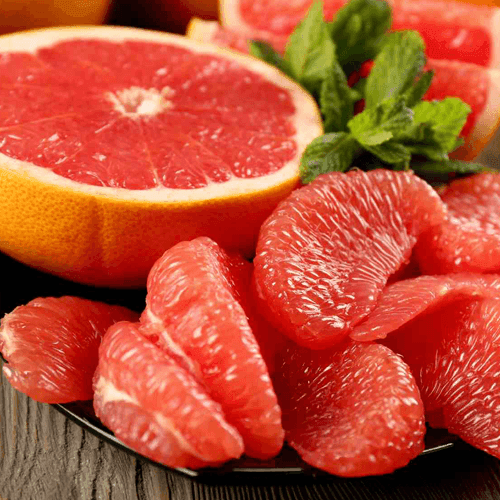Characteristics
The organic pink grapefruit grows and bears fruit on the Riviera dei Gelsomini, giving particularly tasty and fragrant fruits. It is a citrus fruit of a fairly large size that has countless beneficial properties : it is an excellent ally of the heart, as it reduces the levels of bad cholesterol in the blood, it is also rich in nutrients, rich in fiber and vitamins for our body.
Advice
It is commonly associated with the “healthy” image of the diet, in fact it often appears in recipes and slimming diets due to its low calorie intake and its rich vitamin content as well as for the creation of juices, salads, sorbets, granitas and digestives. It is also considered an excellent digestive with diuretic, disinfectant and anti-tumor effects. Some scholars write that drinking 250ml of juice a day could triple the effects of a dose of anti-cancer drugs. It contains many B vitamins, about 80mg of Vitamin C and large quantities of fiber and mineral salts.
For ideas on how to use it, check out the recipes on our blog to get inspired and learn about this fruit. You can make healthy juices, learn how to use it to enhance the flavor of sweet dishes (e.g. candied fruit , jams), savory dishes, and excellent salads ( GRAPEFRUIT AND AVOCADO SALAD )
The fruit
- The very juicy pulp has a very particular acidic, bitter and sweet flavour at the same time.
- In the first fruits of the season, the early fruits, the acidity is more accentuated which decreases with ripening.
- The peel is calloused and thick. For use in cooking it is necessary to remove the white part (albedo) which is rather thick and bitterish.
- The pulp is pink with some seeds. Very rich in juice.
- Average weight: 250 - 300 g (about 3/4 fruits per kg)
Ripening period
This citrus fruit is picked from the first ten days of October until the beginning of spring.
The "digital supply chain" is a model of sustainability
Ours is a digital model that does not only mean getting directly from the producer to the consumer, but a way of doing things that has an impact on our sustainability and on the quality of the products that we manage to bring to your table. You will feel the difference!
Sustainable for the environment
Avoiding remunerating all the intermediate steps of the traditional supply chain (often only commercial) helps to make the price to the consumer more transparent and allows the farm to allocate the right resources to practice sustainable agriculture.
Social and cultural sustainability
The digital supply chain has a concrete impact on the territory, not only economically! It means being able to provide work for (logistics, social media, marketing, etc.), but also having links with institutions, associations, people to whom we turn to communicate our model with educational, social or pure entertainment activities ( see HERE ).
Sustainability for the farm
Skipping the intermediate steps also means having direct contact with the customer trying to explain what the value of your product is, which being 100% organic sometimes is not perfect on the outside but it is on the inside. This also helps to minimize waste (i.e. the non-perfect products that the GDO would throw away)
Sustainability for the consumer
It allows access to quality products at the right price, with greater guarantees. The customer "looks in the face" directly those who have sweated to produce and those who put in the effort every day to produce have every interest in having a satisfied customer. All this is now impossible in the "impersonal" model of the GDO
FRESH, SEASONAL AND TASTY
Short supply chain is synonymous with freshness and quality that can be perceived between a fruit that arrives at your home within 48 hours of harvesting ripened in the sun of the Riviera dei Gelsomini instead of the 5/7 days of a fruit harvested a little later in ripening to last longer than the traditional supply chain
Fresh and perfectly ripe products
Our products are picked fresh and above all naturally ripened in the sun of the Riviera dei Gelsomini: you will taste the flavour!
Seasonal Fruits and Typical Local Varieties
We have decided to recover old varieties that have now been commercially abandoned in favor of standardized ones that are more suitable for large-scale retail trade processing, often to the detriment of the taste and quality of the products.


